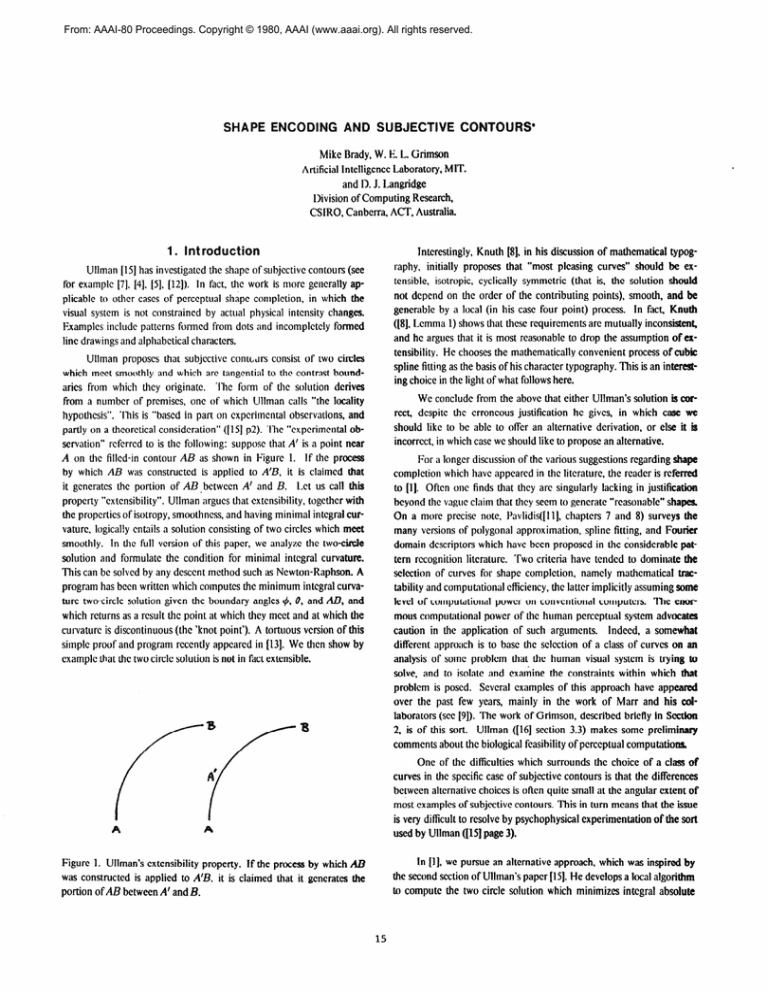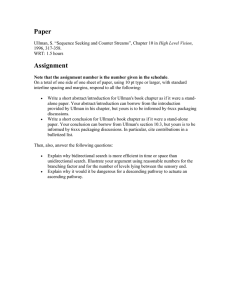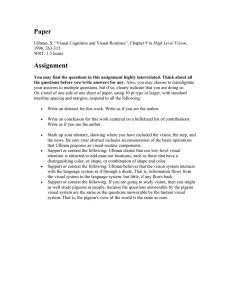
From: AAAI-80 Proceedings. Copyright © 1980, AAAI (www.aaai.org). All rights reserved.
SHAPE ENCODING
AND SUBJECTIVE
CONTOURS’
Mike Brady, W. E. L. Grimson
Artificial Intelligence Laboratory, MIT.
and D. J. Langridge
Division of Computing Research,
CSIRO, Canberra, ACT, Australia.
1. Int reduction
lntcrestingly, Knuth [S]. in his discussion of mathematical typog
raphy, initially proposes that “most plcasing curves” should be extensible, isotropic, cyclically symmetric (that is, the solution should
not depend on the order of the contributing points), smooth, and be
generable by a local (in his case four point) process. In fact, Knuth
([8]. Lemma 1) shows that these requirements arc mutually inconsistent,
and hc argues that it is most reasonable to drop the assumption of extensibility. He chooses the mathematically convenient process of cubic
spline fitting as the basis of his character typography. This is an in
ing choice in the light of what follows here.
Ullman [15] has investigated the shape of subjective contours (see
for example [7]. [4]. [5], (121). In fact, the work is more generally applicable to other cases of pcrccptual shape completion, in which the
visual system is not constrained by actual physical intensity changes.
Examples include patterns foimcd from dots and incomplctcly
line drawings and alphabetical characters.
Ullman proposes that subjective contc,.us consist of two circles
which meet smoothly and which arc tangential to the contrast boundaries from which they originate. The foim of the solution derives
from a number of premises, one of which Ullman calls “the locality
hypothesis”. ‘Ihis is “based in part on cxpcrimcntal obscrvntions, and
partly on a theoretical consideration” ([I 51 ~2). ‘I’hc “cxpcrimcntal observation” rcfcrrcd to is the following: suppose that A’ is a point near
A on the filled-in contour AB as shown in Figure 1. If the process
by which AB was constructed is applied to A’B, it is claimed that
it gcneratcs the portion of AJ3, bctwccn A’ and B. Let us call this
property “cxtcnsibility”. Ullman argues that cxtcnsibility, togcthcr with
the propcrtics of isotropy, smoothness, and having minimal integral curvature, logically entails a solution consisting of two circles which meet
smoothly. In the fit11version of this paper, we analyze the two-cti
solution and formulate the condition for minimal integral curvature.
This can bc solved by any descent method such as Newton-Raphson. A
program has been written which computes the minimum integral curvature two-circle solution given the boundary angles 4, 8, and AB, and
which returns as a result the point at which they meet and at which the
curvature is discontinuous (the ‘knot point’). A tortuous version of this
simple proof and program recently appcarcd in [13]. We then show by
example that the two circle solution is not in fact extensible.
We conclude from the above that either Ullman’s solution is
rect, despite the erroneous justification he gives, in which case
should like to be able to offer an alternative derivation, or else
incorrect, in which case we should like to propose an alternative.
For a longer discussion of the various suggestions regarding
completion which have appeared in the litcraturc, the reader is rc
to [ll. Often one finds that they are singularly lacking in justifi
beyond the vague claim that they seem to generate “rcasonablc” sham
On a more precise note, Pavlidis([ 111,chapters 7 and 8) surveys the
many versions of polygonal approximation, spline fitting, and Fourier
domain descriptors which have been proposed in the considcra
tern recognition literature Two criteria have tended to domit
selection of curves for shape completion, namely mathcmatic
tability and computational efficiency, the latter implicitly assuming some
level of computational power on conventional computers. The enormous computational power of the human perceptual system advocates
caution in the application of such arguments. Indeed, a somewhat
different approach is to base the sclcction of a class of curves on an
analysis of some problem that the human visual system is trying to
solve, and to isolate and examine the constraints within which that
problem is posed. Several examples of this approach have app
over the past few years, mainly in the work of Marr and his cdlaborators (see [9]). The work of Grimson, described briefly in Section
2. is of this sort. Ullman ([I61 section 3.3) makes some prclimi
comments about the biological feasibility of pcrccptual computations,
One of the difficulties which surrounds the choice of a class of
curves in the specific case of subjective contours is that the differences
between altcrnativc choices is often quite small at the angular extent of
most examples of subjective contours. This in turn means that the issue
is very difficult to resolve by psychophysical experimentation of the sort
used by Ullman ([lS] page 3).
In [I], we pursue an alternative approach, which was inspired by
the second section of Ullman’s paper [151.He develops a local algorithm
to compute the two circle solution which minimizes integral absolute
Figure 1. Ullman’s extensibility property. If the process by which AD
was constructed is applied to A’B, it is claimed that it generates the
portion of AB between A’and B.
15
curvature. This naturally suggests dispensing with the cxtcnsibility assumption cntircly, just as Knuth did, and proceeding to find a solution which minimizes some “pcrformancc index” related to curvature n,
such as abs(n) or $. In order to test this idea, we apply the ideas of
modern control theory (see [14],[2]).
close approximation to curvature when the gradient fi is small. This is
a reasonable condition to impose in the case of subjective contours, a
point which we argue at greater length in PI.
WC proceed to set up the Hamiltonian as usual. The boundary
conditions arc as follows: (1) z = 0, y = 0, w = 4 (2) z = t, y = 0,
w = -0 = yt. where w = 2, ?~n= 9, and the plant equations
are:
Yl = w
(= &)
WI =u
Since ICand abs(K) are non-conservative, WCconsider minimizing
$. We develop the Hamiltonian and show that it leads to a particularly
intractable diffcrcntial equation namely,
(1)
U2
Setting $$&equal to zero in the usual way, and solving 8$ = XI and
g = -pl, leads to
~=AxZ-p,
In order to proceed, WCsuggest in Section 2 that the shape completion problem considcrcd hcrc is a two-dimcnsionnl analoguc of the
problem of interpolating a three-dimensional surface, for example from
the rclativcly sparse set of disparity points gcncratcd by the MarrPoggio [IO] stereo algorithm. ‘I’his problem has rcccntly been studied
by Grimson [6]. He proposes that the pcrformancc index should be
a semi-norm and shows that many of the obvious pcrformancc indices
rclatcd to curvature, such as $ and abs(lc), do not have this property.
He notes that the quadratic variation, defined by f2,* in two dimensions,
is not only a semi-norm but is a close approx imation to curvature when
the gradicn t fi is small (subscripts indicate partial dcrivativcs). ‘This
is a rcasonablc condition to i::lpose in the case of subjcctivc contours.
Accordingly, WCset LIP the 1lomiltonian for the quadr‘rtic variation and
show that it lcads to a cubic, which rcduccs to a parabola in the case of
equal angles. This is particularly intcrcsting in view of the comments
made about Knuth’s work above.
2. Minimizing
quadratic
‘I’hc Clamiltonian statefunction is
while the pcrformancc index is $.
given by
where h is the Lagrange multiplier, and u is a constant of integration.
This almost certainly does not have a closed form analytical solution.
One possible iinc of approach at this juncture would be to base a local
computation on one of the known techniques for the numerical solution
of ordinary differential equations. Although shooting methods [3] are an
obvious method on which to base such a local computation, WChave not
yet explored the idea.
where p is a constant of integration. This integrates easily to yield the
cubic solution
3
2
y+-$+ux+T,
where u and r are further constants of integration. Inserting the boundary conditions enables us to solve for h, p, u, and r. We get finally
x2
x3
y = t;l(tanfI - tanf$) + t(tan$
-
2 tan@ + ztan0.
In Figure 2, WC showed Ullman’s solution for the case 0 =
30”, 4 = 20’. In Figure 3 WCshow the curve generated by our method,
and in Figure 4 WCoverlay the two. Clearly, the diffcrencc between
the solutions is quite small at the angular extent shown in the figures.
(Further examples arc given in [I]). As WCpointed out in the Introduction,
this limits the usefulness of the kind of psychophysical experimentation
used by Ullman to decide which solution is adopted by humans.
variation
In order to proceed, we suggest that the shape completion problem
considered here is a two-dimensional analoguc of the problem of interpolating a three-dimensional surface, for example from the relatively
In cast the angles 4 and 0 are equal, the cubic term is zero and the
solution reduces to a parabola, namely
2
sparse set of disparity points generated by the Marr-Poggio [lo] stereo
algorithm. More generally, WCsuggest that the process by which subjective contours are gcncratcd results from the “mis-application” to twodimensional figures of a process whose main purpose is the interpolation of three-dimensional surfaces. This idea requires some justification,
which space here does not permit (see [l]). It also gives a different
perspective on subjective contours, and leads to some fascinating, testable hypotheses.
y=
-Z-tanB+ztanf?.
t
The apex is at (1, 6 tan 8) and the focal length is &.
Hence the
focus is below the lint AB so long as 0 < 4, which is normally the case
for subjective contours.
In the cast 0 = 4, it is straightforward to compute the difference
between the parabola gcncrated by our method and the circle predicted
by Ullman, which is
The three-dimensional interpolation problem has recently been
studied by Crimson [6] in the context of human stcreopsis. He observes
that a prcrcquisite to finding the optimal fimction satisfying a given
set of boundary conditions (namely that they should all pass through
the given set of sparse points), is that the functions be comparable.
Translating this into mathematics, hc proposes that the performance index should be a semi-norm. Most importantly, hc shows that many of
the obvious performance indices related to curvature, such as $ and
abs(K), do not have this property. He notes that the quadratic variation,
defined by f2,, in two dimensions, is not only a semi-norm but is a
Using the approximation
(1 -
16
[4] Coren “Subjective contours and apparent depth,” Psychol. Review 79
(1972) 359-367.
this reduces to
II=
v - 4
-ztanB+
wz2tan30.
t
[5) I;risby and Clatworthy “Illusory contours: curious cases of simultancous brightness contrast.,3 ” Perceprion 4 (1975), 349-357.
The diffcrencc bctwcen the solutions is essentially given by the second
term whose maximum is at z = 4. Dividing by the horizontal extent
t of the curve, the relative difference is bounded by w.
For 8 < 1
this is negligible.
[6] Grimson Computing shape using a theory of human stereo vision,
Ph.D. ‘I’hcsis,Department of Dept. of Mathematics, MIT, 1980.
[7] Kanisza “Subjective contours,” Sci. Artrer.234 (1976), 48-52.
3. Acknowledgements
]$I Knuth “Mathematical typography,” Bull. Amer. M&h. Sot. (new
series) 1(1979), 337-372.
This report describes research done in part at the Artificial Intelligence Laboratory of the Massachusetts lnstitute of Technology. Support
for the laboratory’s artificial intelligence research is provided in part by
the Advanced Research Projects Agency of the Dcpartmcnt of Defense
under Office of Naval Research contract N00014-75-C-0643.The authors
would like to thank the following people for valuable discussions at
various stages of the research described here: John Greenman, Pat
Hayes, David Marr, Slava Prazdny, Chris Rowbury. Robin Stanton, and
Shimon Ullman.
19) Marr Vision, Freeman, San Francisco, 1980.
[LO)Marr and Poggio “A theory of human stereo vision,” Proc. R. Sot.
Lond B 204 (1979) 301-328.
Pavlidis Slrucrural Partern Recognition , Springer Verlag, Berlin,
1977.
]I4 Rowbury Apparent contours, Univ. of Essex, UK,, 1978.
[Ill
* This paper will appear as MIT AI memo 582. Here intelligibility
and content have been sacrificed in the intcrcsts of strict page limit
brevity.
]13] Wutkowski “Shape completion,” Computer Graphics and Image
Processing 9 (1979), 89-101.
1141 Schultz and Melsa State functions and linear control systems ,
4. References
McGraw Hill, New York, 1967.
[I] Rrady, Crimson, and Langridge “Shape encoding and subjective contours,” (1980) to apEear.
[IS] Ullman “Filling the gaps: The shape of subjective contours and a
model for their generation,” Biof. Cyb. 25 (1976) l-6.
1[2]Hryson and Ho Applied oplimal confrol, Ginn, Waltham MA, 1969.
1161Ullman “Relaxation and constrained optimisation by local processes,”
Compuler Graphics and Image Processing IO(1979). 115-125.
[3) Come and de Boor Elementary numerical analysis , McGraw Hill,
Tokyo, 1972.
.
.
.
.
.
.
.
.
.
Figure 2. Ullman’s solution for the case of boundary angles0 =
30”, 4 = 20”.
Figure 3. The solution generated by the method proposed in this paper.
The boundary conditions are the same as those of Figure 2.
........
........
.....
.....
... .
.......
.
......
. ........... .........
.............
..............
...........
....
....
.
.
.
,
.
.
Figure 4. The solutions of Figure 2 and Figure 3 are overlayed to
demonstrate the difference between them.
17
.
.
.
...
....
.
.


